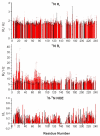Adenoviral E1A Exploits Flexibility and Disorder to Target Cellular Proteins
- PMID: 33187345
- PMCID: PMC7698142
- DOI: 10.3390/biom10111541
Adenoviral E1A Exploits Flexibility and Disorder to Target Cellular Proteins
Abstract
Direct interaction between intrinsically disordered proteins (IDPs) is often difficult to characterize hampering the elucidation of their binding mechanism. Particularly challenging is the study of fuzzy complexes, in which the intrinsically disordered proteins or regions retain conformational freedom within the assembly. To date, nuclear magnetic resonance spectroscopy has proven to be one of the most powerful techniques to characterize at the atomic level intrinsically disordered proteins and their interactions, including those cases where the formed complexes are highly dynamic. Here, we present the characterization of the interaction between a viral protein, the Early region 1A protein from Adenovirus (E1A), and a disordered region of the human CREB-binding protein, namely the fourth intrinsically disordered linker CBP-ID4. E1A was widely studied as a prototypical viral oncogene. Its interaction with two folded domains of CBP was mapped, providing hints for understanding some functional aspects of the interaction with this transcriptional coactivator. However, the role of the flexible linker connecting these two globular domains of CBP in this interaction was never explored before.
Keywords: CBP; E1A; IDP; NMR; fuzzy complex.
Conflict of interest statement
The authors declare no conflict of interest.
Figures









Similar articles
-
Mapping the interactions of adenoviral E1A proteins with the p160 nuclear receptor coactivator binding domain of CBP.Protein Sci. 2016 Dec;25(12):2256-2267. doi: 10.1002/pro.3059. Epub 2016 Oct 15. Protein Sci. 2016. PMID: 27699893 Free PMC article.
-
Modulation of allostery by protein intrinsic disorder.Nature. 2013 Jun 20;498(7454):390-4. doi: 10.1038/nature12294. Nature. 2013. PMID: 23783631 Free PMC article.
-
Comparison of E1A CR3-dependent transcriptional activation across six different human adenovirus subgroups.J Virol. 2010 Dec;84(24):12771-81. doi: 10.1128/JVI.01243-10. Epub 2010 Sep 29. J Virol. 2010. PMID: 20881041 Free PMC article.
-
Role of Intrinsic Protein Disorder in the Function and Interactions of the Transcriptional Coactivators CREB-binding Protein (CBP) and p300.J Biol Chem. 2016 Mar 25;291(13):6714-22. doi: 10.1074/jbc.R115.692020. Epub 2016 Feb 5. J Biol Chem. 2016. PMID: 26851278 Free PMC article. Review.
-
Hacking the Cell: Network Intrusion and Exploitation by Adenovirus E1A.mBio. 2018 May 1;9(3):e00390-18. doi: 10.1128/mBio.00390-18. mBio. 2018. PMID: 29717008 Free PMC article. Review.
Cited by
-
The Role of Disordered Regions in Orchestrating the Properties of Multidomain Proteins: The SARS-CoV-2 Nucleocapsid Protein and Its Interaction with Enoxaparin.Biomolecules. 2022 Sep 15;12(9):1302. doi: 10.3390/biom12091302. Biomolecules. 2022. PMID: 36139141 Free PMC article.
-
Chemistry towards Biology-Instruct: Snapshot.Int J Mol Sci. 2022 Nov 26;23(23):14815. doi: 10.3390/ijms232314815. Int J Mol Sci. 2022. PMID: 36499140 Free PMC article. Review.
-
Early Strides in NMR Dynamics Measurements.Biochemistry. 2021 Nov 23;60(46):3452-3454. doi: 10.1021/acs.biochem.1c00141. Epub 2021 Mar 30. Biochemistry. 2021. PMID: 33784452 Free PMC article.
-
Vital for Viruses: Intrinsically Disordered Proteins.J Mol Biol. 2023 Jun 1;435(11):167860. doi: 10.1016/j.jmb.2022.167860. Epub 2023 Jun 16. J Mol Biol. 2023. PMID: 37330280 Free PMC article. Review.
-
NMR illuminates intrinsic disorder.Curr Opin Struct Biol. 2021 Oct;70:44-52. doi: 10.1016/j.sbi.2021.03.015. Epub 2021 May 2. Curr Opin Struct Biol. 2021. PMID: 33951592 Free PMC article. Review.
References
Publication types
MeSH terms
Substances
Grants and funding
LinkOut - more resources
Full Text Sources

